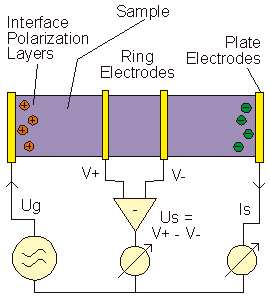Three- and Four-Electrode Measurements
Electrode / Interface Polarization Effects
In a measurement of a material prepared between two parallel plate electrodes with spacing d, the complex permittivity, conductivity or impedance is evaluated from the phase sensitive measurement of the electrodes voltage difference US and current IS. This method presumes that the applied voltage US drops homogeneously within the material by creating a constant electric field E=US/d.
This presumption does not hold if at the electrode sample interface electrical inhomogeneous layers exist which create a significant voltage drop and by this reduce the E-field in the sample. Such layers may be created by
- accumulation of ions at the electrode for ion conductors like e.g. electrolytes and many liquids (water, electrode polarization);
- bad electrode sample contact connections (contact impedance).
For low-impedance samples, similar effects may be created by non-negligible impedance contributions of the cables connecting the electrodes and the analyzer voltage and current terminals.
In principle, however, these effects can be suppressed if separate electrodes for the sample current and voltage measurement are used as shown below.

If the two voltages are measured by an instrument with infinite input impedance, the current flow into the voltage electrodes will be negligible. As a consequence, the ions will not accumulate here. Due to the negligible current, contact or cable impedance contributions will not create any voltage drop as well. In this case, the electrical parameters of the material portion between the voltage electrodes can be evaluated without interface polarization contribution and without contact or cable effects from the voltage drop between the voltage electrodes and the current flowing through the outer electrodes. The only, but in practice crucial and frequently unfulfilled requirement, however, is a sufficiently high input impedance of the voltage channels.
The Novocontrol device configurations
- Alpha-A analyzer series with ZG4 test interface
- Alpha-A analyzer series with POT/GAL test interface
- Beta analyzer series
- NEISYS analyzer series
On the other hand, especially for high impedance samples at high frequencies the 10 pF input capacity may be of the same order of magnitude as the sample capacity and may thus contribute to the measured result. Three- and four-electrode measurements therefore in practice always require a detailed analysis of the currents flowing into the voltage terminals and the related voltage drop at contacts or electrode interfaces.
